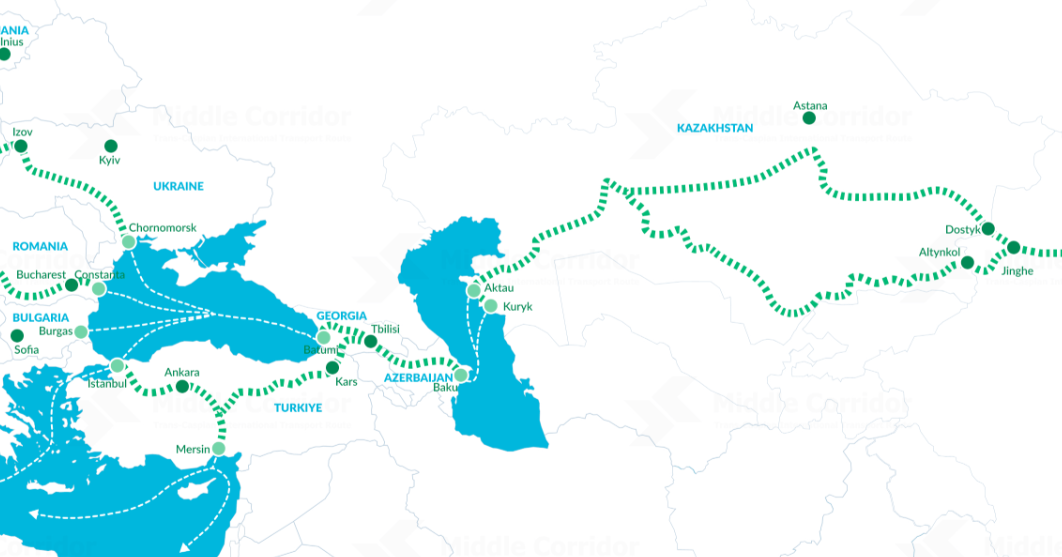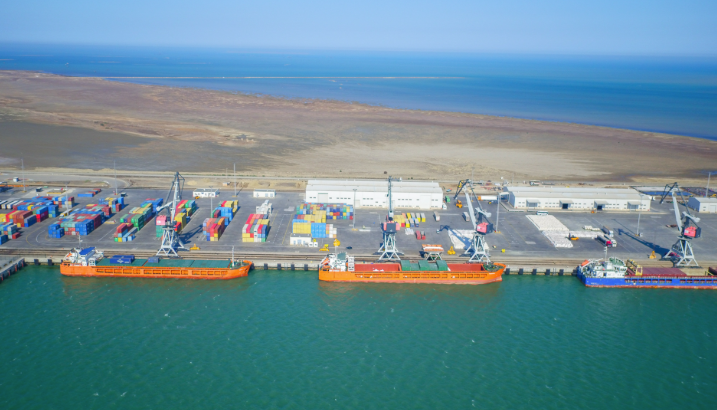
The Port of Baku Facilitates Trans-Eurasian Commerce (Part Two)
The Port of Baku Facilitates Trans-Eurasian Commerce (Part Two)
Executive Summary:
- Azerbaijan is responding to increased trade through the Middle Corridor with international partnerships and ambitious reforms of its railway and port systems, highlighting Baku’s desire to become a critical node in global trade.
- Reforms such as standardized cargo procedures, digital customs systems, and regional e-services are streamlining transit operations at the Port of Baku, improving coordination across borders, and enhancing the Middle Corridor’s competitiveness in global logistics.
- The Port of Baku leads regional green initiatives, but threats from declining water levels in the Caspian Sea and climate change pose long-term risks to port infrastructure and regional transport continuity.
Azerbaijan is embarking on ambitious reforms and collaborations within its transport and logistics sector, driven by the opportunities presented by the Middle Corridor trade route. Initiatives such as the integration of Azerbaijan’s railway and port systems and the establishment of international partnerships signal a push toward greater efficiency and connectivity in trade infrastructure (see EDM, May 1). On April 25, Azerbaijani Foreign Minister Jeyhun Bayramov, during a press conference with Kaja Kallas, EU High Representative for Foreign Affairs and Security Policy, stated that work is underway to increase the cargo capacity at the Port of Baku from 15 million tons to 25 million tons (European Council; Report.az, April 25). Efforts such as this underscore Baku’s vision of transforming the country into a critical node of global trade routes, reinforcing regional connectivity and contributing to economic diversification (see EDM, January 28).
On February 25, Azerbaijani President Ilham Aliyev signed a decree that merged Azerbaijan Railways Joint Stock Company with the Baku International Sea Trade Port to streamline Azerbaijan’s transport and logistics sector (Trend News Agency, February 25). The merger is expected to create a more cohesive and efficient transport network, facilitating faster cargo transit and reducing operational redundancies.
The Port of Baku has maintained “sister port” agreements with Kazakhstan’s Port of Aktau and Türkiye’s Port of Samsun since 2013 to optimize transport through the Middle Corridor as a whole (TURKPA, 2013; Turkic Council, 2019; Insight Turkey, March 30, 2023; Organization of Turkic States, November 19, 2024). Azerbaijan continued to cooperate with other Middle Corridor countries and, in mid-2022, established a partnership with Türkiye’s Albayrak Group to enhance port management and improve bulk cargo handling efficiency through the exchange of best practices (Trend News Agency, July 15, 2022; Institute for Development and Diplomacy, December 1, 2022; see EDM, February 19).
In a move to bolster regional connectivity and trade efficiency, the Port of Baku, Kazakhstan Railways, and Xi’an Free Trade Port Construction and Operation Co. signed a trilateral agreement at COP29, the UN Climate Change Conference held in Baku in November 2024 (Azerbaijan Investment Holding, November 12, 2024). The main feature of the agreement is the construction of a 40-hectare intermodal cargo terminal at the Port of Baku, which will increase the port’s cargo handling capacity, cut transportation expenses, and shorten transit times by optimizing the reloading and unloading processes. The collaboration leverages the combined logistics-sector strengths of Azerbaijan, Kazakhstan, and the People’s Republic of China (PRC). The Port of Baku’s advanced infrastructure provides an entry point for cargo transit, while Kazakhstan Railways facilitates freight movement across the Eurasian landmass. The Xi’an Free Trade Port’s experience in organizing container trains on the PRC-Europe route will help increase the efficiency of the supply chain (The Caspian Post, September 22, 2024).
Azerbaijan’s Ministry of Digital Development and Transport introduced standardized procedures for managing cargo at the Port of Baku in 2022. These “Procedural Rules” establish clear guidelines for handling transit cargo, ensuring consistency and predictability in maritime freight operations along the Middle Corridor (Ministry of Digital Development and Transport of the Republic of Azerbaijan, July 22, 2022). Azerbaijan’s government is working on implementing similar regulatory frameworks at other border-crossing points to harmonize and digitize Azerbaijan’s transit freight sector. The goal is to launch a “Digital Customs Value” system by September 1 of this year, promoting transparency and equity in customs valuation, while continuing to standardize logistics sector regulations (AzerNews, March 4).
In addition to logistical improvements, the Port of Baku has made substantial progress in adopting eco-friendly technologies. In 2019, it became the first “Green Seaport” in the Caspian Basin (Report News Agency, October 17, 2019). The port has significantly reduced its carbon footprint and improved operations by integrating renewable energy sources and environmentally responsible waste management systems. The port’s leadership has set an ambitious goal of achieving net-zero emissions by 2035 by adopting advanced technologies (Trend News Agency, May 17, 2024; Report News Agency, November 20, 2024).
The rapid growth of the Middle Corridor after Russia’s full-scale invasion of Ukraine has exposed logistical bottlenecks and capacity constraints requiring urgent attention (Railway Supply, December 15, 2022; Gunnar, The South Caucasian Transport Corridor: A New Eurasian Transport Option, March 2024). The trans-Caspian segment of the Middle Corridor presents a multimodal bottleneck as cargo transfer between trains, ships, and trucks creates delays (Urciuolo, The Middle Corridor’s Reality Check: Advancements and Challenges in Port Infrastructure in the Greater Caspian Region, April 2025).
An often-overlooked but critical challenge facing the Port of Baku is the ongoing reduction in the Caspian Sea’s water level, driven by rising regional temperatures, decreased river inflow, and increased evaporation rates (The Central Asia-Caucasus Analyst, October 13, 2023; see EDM, March 18). Projections suggest that the Caspian Sea will drop 9 to 18 meters (~30 feet to ~60 feet) by the end of the century, a decline that is increasingly attributed to climate change (see EDM, November 16, 2023, March 18). This decrease poses severe risks to coastal enterprises and infrastructure, including ports (Geographical, October 30, 2024; Euronews, November 16, 2024). In addition to climate change, a significant factor contributing to the Caspian’s shrinking water level is the reduction in inflow from its tributary rivers, most notably the Volga River (Azernews, April 5, 2024; President of Azerbaijan, August 19, 2024; see EDM, March 18). The Volga River is the largest single source of water for the Caspian Sea, and its discharge volume has been affected by both natural variations in precipitation within its basin and intensive human utilization (Institute for Development and Diplomacy, December 23, 2022).
The Port of Baku is a key node in the trans-Eurasian trade ecosystem, enabling Azerbaijan to influence regional transit flows. Enhanced connectivity through Baku yields economic benefits and carries substantial geopolitical weight. It provides Europe and Central Asia greater trade flexibility, minimizing dependence on Russian infrastructure. Consequently, the Port of Baku has become a pivotal node in the evolving Eurasian supply chain, collaborating with programs such as the PRC’s “One Belt One Road” initiative and new EU trade routes (see EDM, May 1). Continued investments and reforms will be key to ensuring the Port of Baku’s sustained growth as a vital transit hub in the heart of Eurasia.


